
[NEW APP] BON Loyalty – An accessible loyalty program
1 March, 2021
Securing Late Payments From Clients and Customers Without Burning Bridges
2 March, 2021
Your consumers will be able to find their favorite products quickly and easily with the help of site search technologies. As a result, now is the time to put them to work in order to improve your strategy and increase revenue.
Ecommerce site search aids store owners in improving search performance, which boosts sales. According to Baymard, searching for products is preferable than browsing via categories because it is faster. Despite the fact that online shoppers love using this feature, 61% of eCommerce sites perform below acceptable levels. As a result, instead of staying with you and completing a purchase, visitors will look elsewhere.
Here are the best search trends to use when developing an online store to get relevant results for even the most complicated search queries.
Smart Autosuggest can help you rank your searches higher#
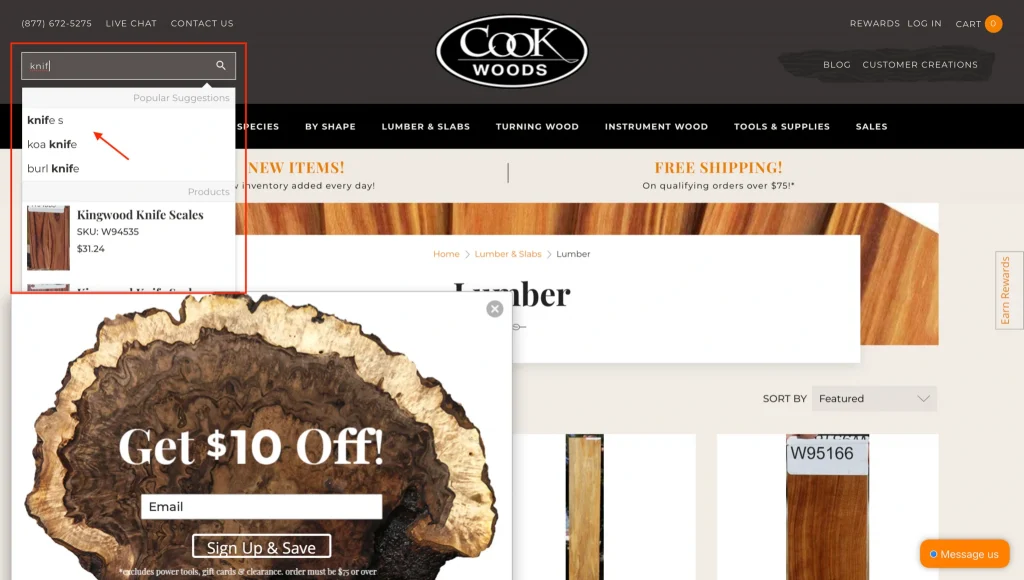
(Source: [Cook Woods](https://www.cookwoods.com/collections/lumber))
What is autosuggest and how does it work? When a visitor types a search phrase into the search box, the search engine provides similar terms to your potential clients. Let’s look at a site search for Cook Woods as an example. When a visitor types ‘knif’ into the search box, it returns rapid results with popular ideas such as ‘koa knife’ and ‘burl knife,’ as well as relevant products like Kingwood Knife Scales.
Your eCommerce site’s search engine can propose the goods or categories most typically connected with that user’s search phrase thanks to intelligent autocomplete. As a result, online customers will be able to find what they want more quickly and correctly. According to a study conducted by Nacho Analytics, adding search autocomplete to a website can increase digital sales by 24 percent. This function is profitable since it assists e-merchants in better understanding their clients, providing an exceptional user experience, and even promoting specific items in a natural and helpful manner.
Here are some helpful hints from well-known brands on how to make the most of this feature.
Remember to highlight suggested results for improved scannability, like Eastwood Guitars has done, to make suggestions stand out. By making search words bold in the results, the brand shows how relevant their recommendations are.
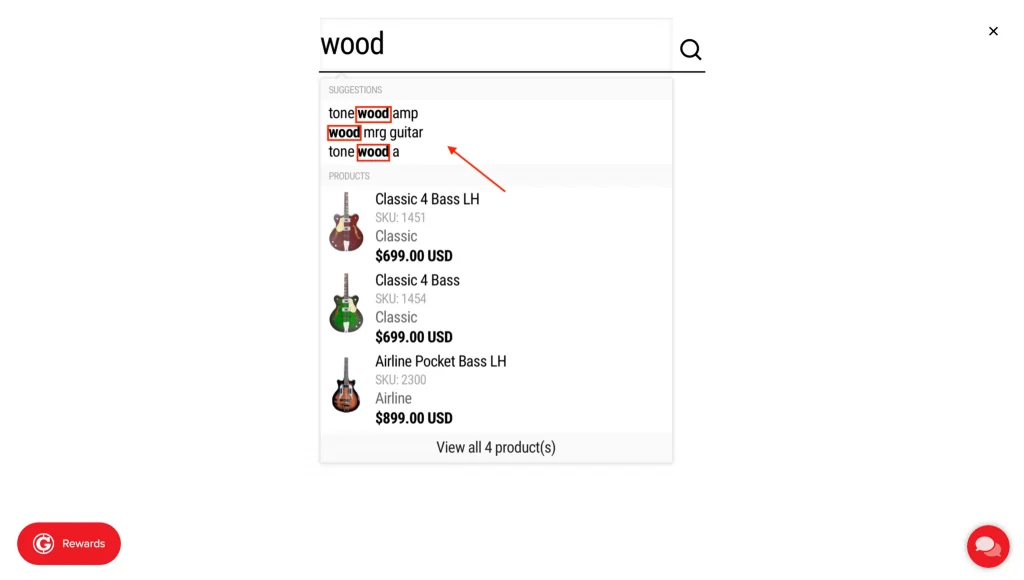
(Source: [Eastwood Guitars](https://eastwoodguitars.com/))
Another option is to collaborate with a federated search engine. In a nutshell, federated search consolidates results from multiple sources into a single user experience. As a result, it can broaden the range of search results available to customers and assist them in finding what they need in a matter of seconds.
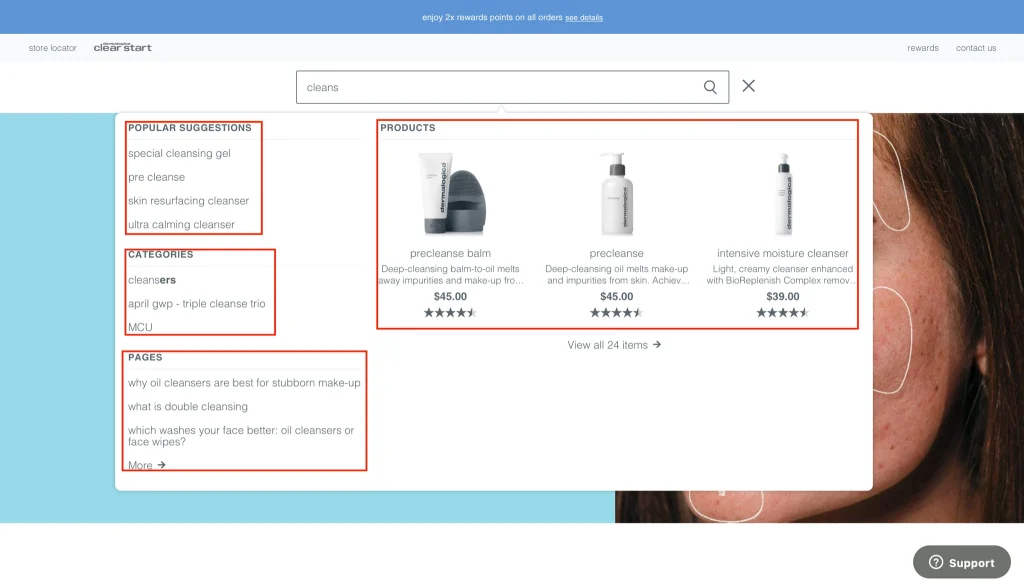
(Source: [Dermalogica](https://www.dermalogica.com/pages/clearstart))
Take look at Dermalogica’s fast search results for more information. A user may access relevant products, related categories, and helpful guides with just a few keystrokes.
To keep your autocomplete list tidy and avoid triggering shoppers choice paralysis, you should restrict the number of provided options. The list will operate best with a maximum of 10 recommendations on desktop and 8 on mobile, according to Baymard.
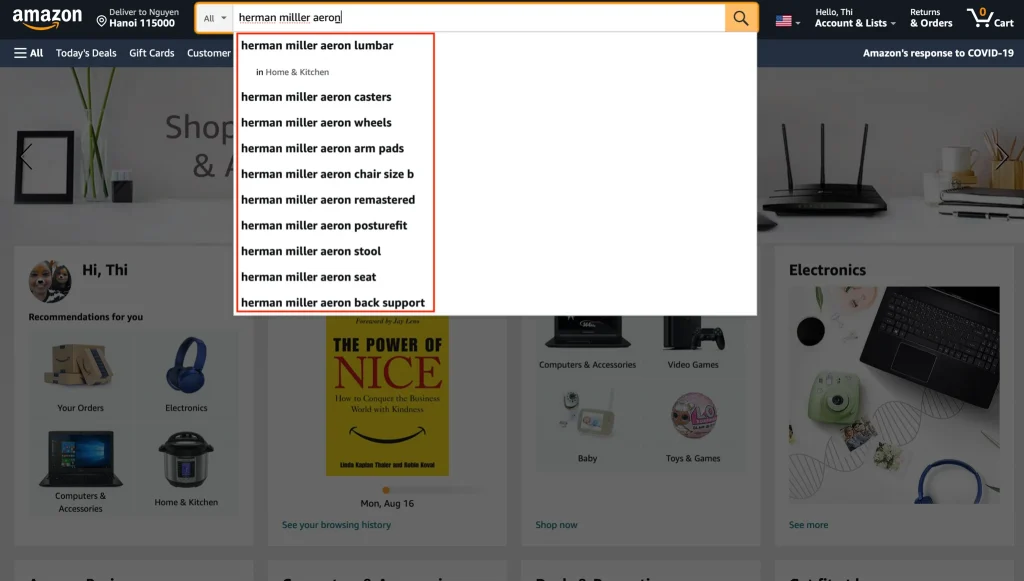
The number of suggestions on the Amazon desktop site is limited to ten, resulting in a short list that online shoppers can see at a glance for faster decision-making. (Source: [Amazon](https://www.amazon.com/))
Aside from saying no to a long list, make sure you leave out some redundancies, as they will make it difficult for your clients to choose the best option. Take your time and go deeper into search analytics to reveal popular search phrases to provide them with the best ideas linked to what they’re looking for.
Faceted Search helps you find what you’re looking for#
We’d be remiss if we didn’t highlight faceted search as a way to improve the search on your eCommerce site. By selecting the aspect options, this phrase refines search results to provide customers their selected products quickly. It also allows customers to experiment with filters intelligently.

(Source: [Yummy Bazaar](https://yummybazaar.com/search?type=article%2Cpage%2Cproduct&q=cookies))
No one has the time or patience to scroll down and look at over 700 cookie options. To that end, Yummy Bazaar provides their online customers with a clever solution in the form of faceted filters, which reduce the number of results based on their preferences. Customers simply need to select their preferred diet, brand, price range, and region.
There’s no denying that using faceted filters helps visitors narrow down search results and improve their chances of finding something they’re interested in. As a result, you’ll increase their chances of making a buy, increasing sales. However, you’re undoubtedly wondering, ‘What types of filters should I apply to my online store?’ Don’t worry; we’ve combined the most important filter kinds, including price, brand, user ratings, size, and color, to optimize conversions and speed up clients’ purchasing decisions.
Let’s have a look at how the businesses below, from a variety of industries, use these elements to provide a positive purchasing experience for their customers.
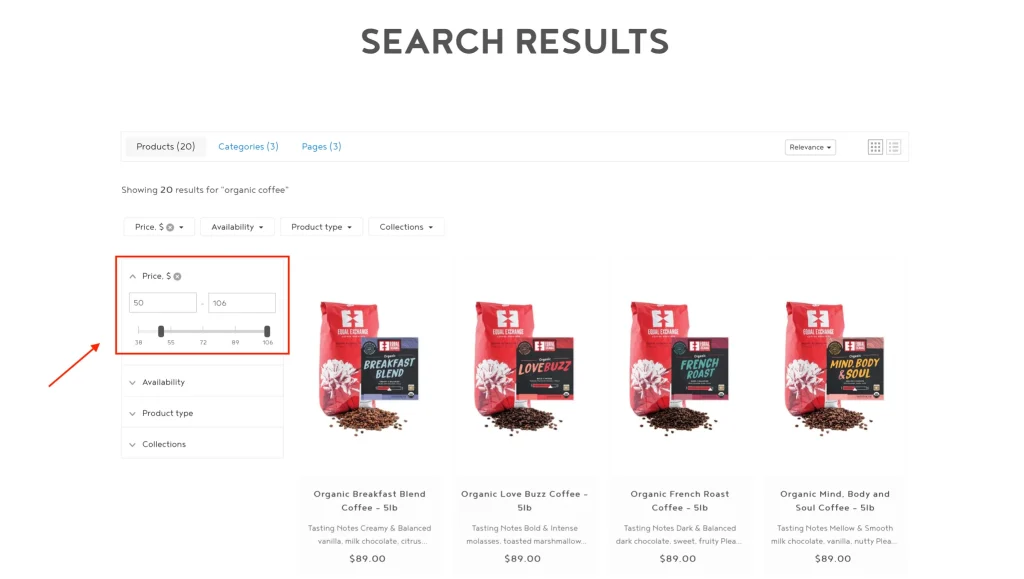
Approximately 80% of consumers filter things based on price, and they typically have an idea of how much they can spend. Equal Exchange provides shoppers with a price filter that includes a range slider and price range alternatives. (Source: Equal Exchange)
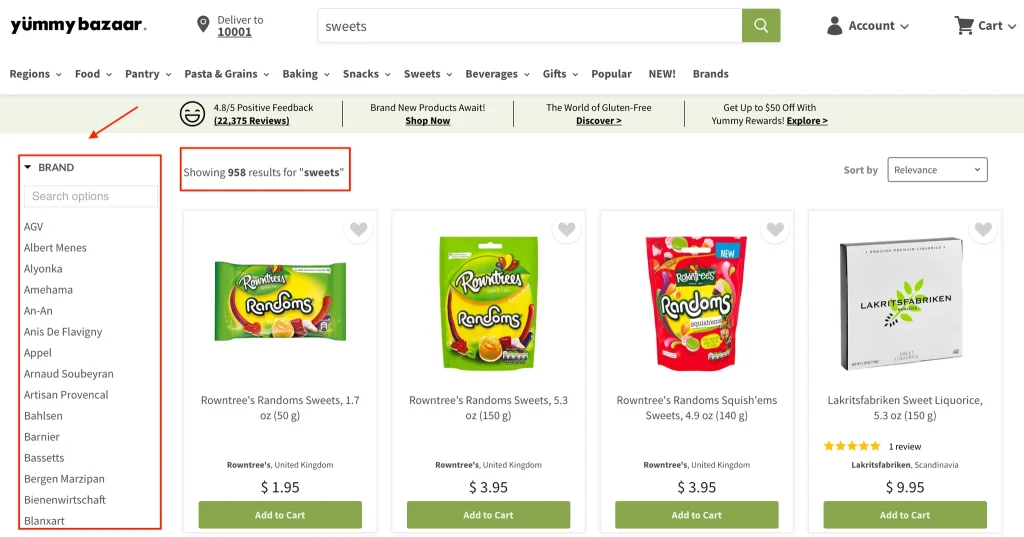
Brand awareness is widespread, especially in the fashion, cosmetics, and food and beverage industries. When looking for something new to try, people are more likely to look for well-known names. A brand filter with a search box, such as the one used by Yummy Bazaar, makes it easier for clients to find the items they want without having to keep scrolling down. (Source: Yummy Bazaar)
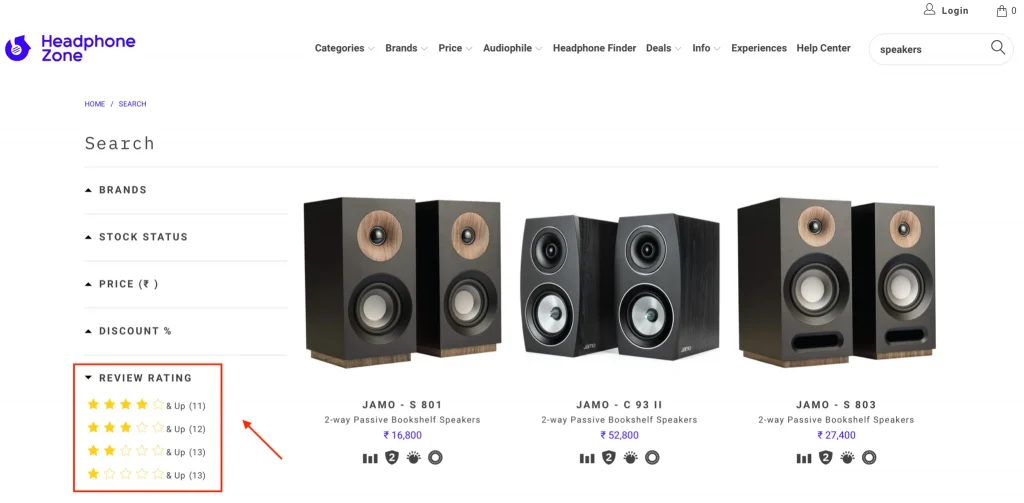
Consumers want to know how much an item is worth before buying it, therefore 45 percent of them said that user reviews are the most important factor when shopping online. Customers are more confident in purchasing Headphone Zone products because of the review ratings. (Source: Headphone Zone)
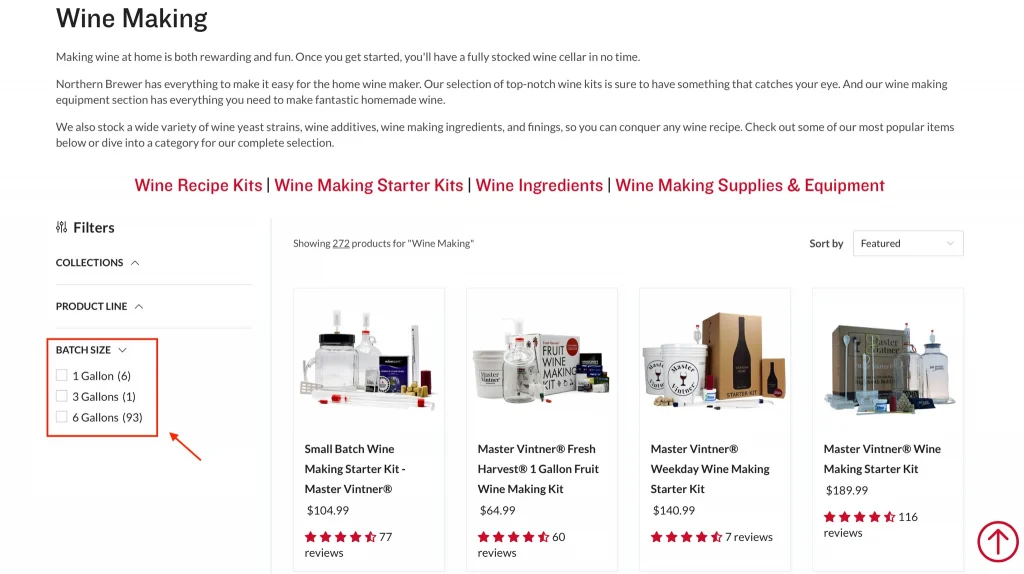
Because your customers can swiftly eliminate things that aren’t right for them, size is an important feature. Northern Brewer creates a size filter for wine-making kits so that online customers can choose whether or not they meet their needs. (Source: Northern Brewer)

People have color preferences, therefore never let them down by allowing them to purchase a product in unfavorable tones due to a lack of color filter options. (Source: Rug Emporium)
In actuality, eCommerce sites offer extra filtering options based on specific criteria like height, location, technology, and so on. Adding these five fundamental filter kinds, on the other hand, is the first step toward creating a ‘state of the art’ UX that boosts conversion rates.
Make Recommendations That Are Personalized#
To adapt to consumers’ expectations, digital commerce is on the lookout for the holy grail of personalization. Personalization in eCommerce refers to the practice of dynamically displaying content, product recommendations, and offers on eCommerce sites based on visitors’ previous activities, browsing activity, purchase history, demographics, and other personal data. As a result, you’ll have an easier time engaging potential customers, increasing repeat purchases, driving sales, and increasing conversions.
It’s not just about relevancy and content boosts when it comes to personalized site search results; it’s also about taking into account characteristics like language, location, search history, and the device used to access the search engine.
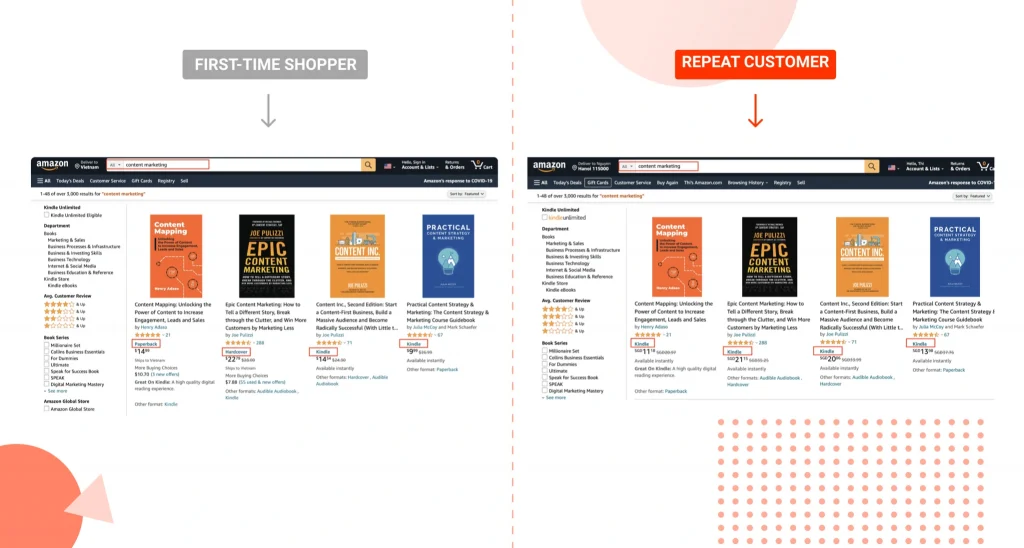
The search results for a first-time shopper and a customer who purchased multiple Kindle books were revealed. (Source: Amazon)
Amazon excels in providing customized product recommendations to online buyers. This behemoth retailer keeps track of every click and purchase made by its customers. You can see how the search results of an established client differ from those of a first-time visitor when both looked for content marketing books in the images above. While the search result page shows several formats to newcomers, a repeat customer who has previously purchased digital books obtains the same items but in Kindle format.
This is an example of how you should actively listen to what your online customers have to say and alter the experience to make it more engaging each time they visit your store. The dynamic customization of eCommerce site search will encourage customers to remain longer and increase their chances of making a purchase.
Natural Language Processing (NLP) can make search results more human#
The fact that site search is based on algorithms rather than human language is one of the key reasons why online retailers do not provide correct search results to customers. In fact, rather of using the names of your products, online consumers frequently employ search words that are closer to natural speech. As a result, machines that communicate in codes have a difficult time understanding what they want.
That’s where natural language processing (NLP) enters the picture. It is, in essence, an AI-based solution that allows computers to comprehend, interpret, and alter conversational discourse. The eCommerce site search engines may now return the same results for synonymous terms thanks to this strong technology. As a result, mismatches between what online buyers seek for and the search results can be avoided.
Consider the terms ‘tops’ and’shirts.’ You could look for tops at Nordstrom. T-shirts, tank tops, and tops appear when you enter in the phrase. In this way, even though you chose a different term, NLP assisted you in finding what you were seeking for.
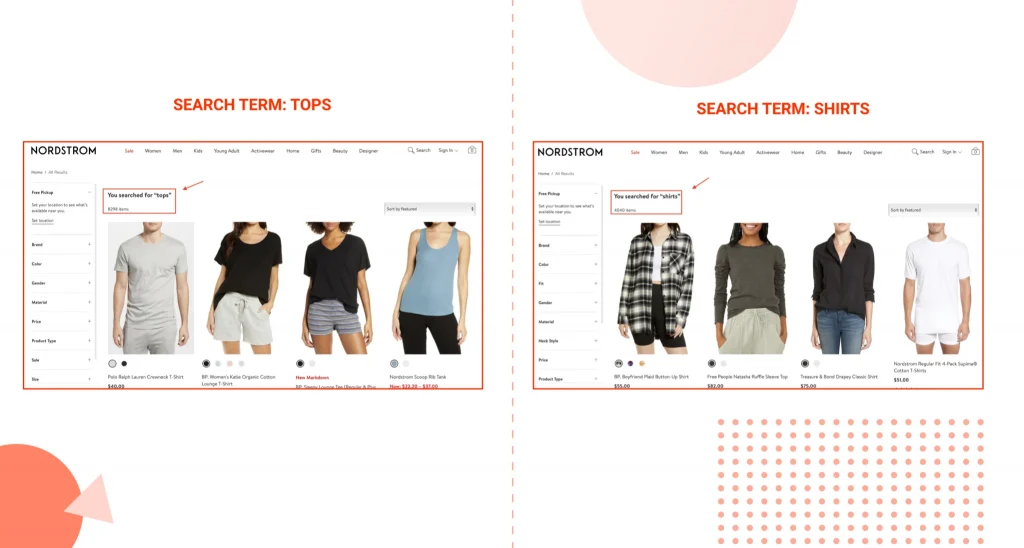
(Source: [Nordstrom](https://www.nordstrom.ca/sr?origin=keywordsearch&keyword=tops))
Prepare to Use eCommerce Site Search#
The next stage in improving your eCommerce site search experience is to apply those site search solutions, and Boost Product Filter & Search is the appropriate choice if you’re looking for a third-party software to take your business to the next level. This software will help your consumers locate appropriate products within milliseconds, boosting sales, thanks to advanced product filters, smart searches, and rapid suggestions, as well as detailed insights of buyer activity.Lorem ipsum dolor sit amet enim. Etiam ullamcorper. Suspendisse a pellentesque dui, non felis. Maecenas malesuada elit lectus felis, malesuada ultricies. Curabitur et ligula.